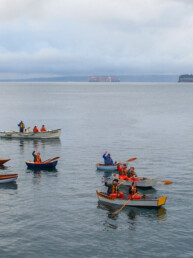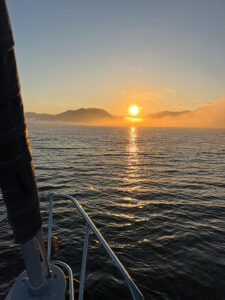
It was the porpoises that sealed the deal.
When your summer cruising plans are to circumnavigate Vancouver Island, you have to be prepared to change your plans based on the conditions. Mostly that means avoiding bad weather or big seas by getting to a protected place and being patient.
But every so often, it means taking advantage of a situation when the factors align in your favor. Sometimes, pushing on is the best course of action. And that was the case for us in August as we approached the big three challenges in rounding the north end of the island — crossing the Nahwitti Bar, then clearing Cape Scott and the Brooks Peninsula.
Deborah and I had shoved off in mid-July from our homeport in Seattle with a loose plan to sail counterclockwise around Vancouver Island. Over the past few years, we have been refitting our 1984 Passport 40, Rounder, with long-distance sailing in mind. As we rushed to finish up some major projects through the winter and spring, we felt it was time to put many of those improvements — and more importantly, ourselves — through some serious sea trials.
In particular, we had just built a new rudder and redesigned and replaced the steering system and bearings. We also had brand-new sails to go with our recently replaced standing rigging.
In addition to all that great new gear, we needed to test ourselves. While we’ve cruised extensively in the Pacific Northwest, including to Southeast Alaska in 2018, we don’t have a lot of open ocean miles under our belts. And we hadn’t done an overnight passage together. We wanted to make sure we were prepared and comfortable doing both of those things before we ventured farther afield.
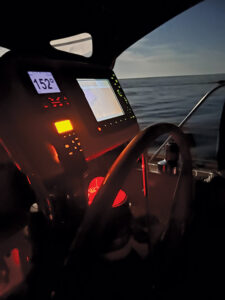
And let’s face it, a circumnavigation of Vancouver Island is one of those accomplishments that many Northwest boaters dream of, but fewer actually achieve.
Over several weeks, we moved the boat up the east side of the island, enjoying time in Desolation Sound and the Broughton Archipelago. We also managed to keep working our day jobs from our floating office while doing so.
Per our plan, we made it up to Port Hardy, the last major town on the northeast side of the island and the traditional final stop before attempting the west coast. It was mid-August and we had two weeks of vacation that we hoped would give us adequate time to explore the many wonderful and remote anchorages and outposts on the wild side of the island.
On a Thursday afternoon at 2 p.m., I hit “end” on my work Zoom meeting, got the diesel engine fired up and waited while Deborah squeezed the last bits of reliable cellular data that we would have for a while. Then we were off.
Our first big test would be crossing the Nahwitti Bar. This can be a nasty stretch of water, thanks to the mix of strong currents, ocean swells, shallow water, the Tatnall Reefs, and big winds. All those forces are focused on a relatively narrow channel between Hope and Vancouver islands.
The most common strategy for pleasure boats is to anchor overnight in nearby Bull Harbour off Hope Island, wait until slack water, sneak around the south end of the reef, check the sea conditions on the bar and then, if safe, scoot across.
That was our plan as we chugged up the 22 miles of Goletas Channel from Port Hardy to Bull Harbour. The seas were flat and the wind mild, but a light curtain of fog hung around and suggested a thicker soup ahead.
The Nahwitti Bar is just the first challenge for boats. Once past it, you face another 20 miles of shelter-less coastline before reaching the infamous Cape Scott on the far northwest corner of the island, a magnet for bad weather and dangerous seas.
Once past Cape Scott, boats tend to head 8 miles south to Sea Otter Cove, a refuge with a tricky entrance best attempted in daylight, or 30 miles south to Winter Harbour in the protected waters of Quatsino Sound.
From there, the next big area of concern for boats heading south is to round the Brooks Peninsula, about 45 miles south of Cape Scott. Sticking out a dozen miles into the Pacific Ocean like a thumb, it tends to amplify winds and sea states into tempests. Smart sailors make sure they know what they are in for before attempting to get past Brooks.
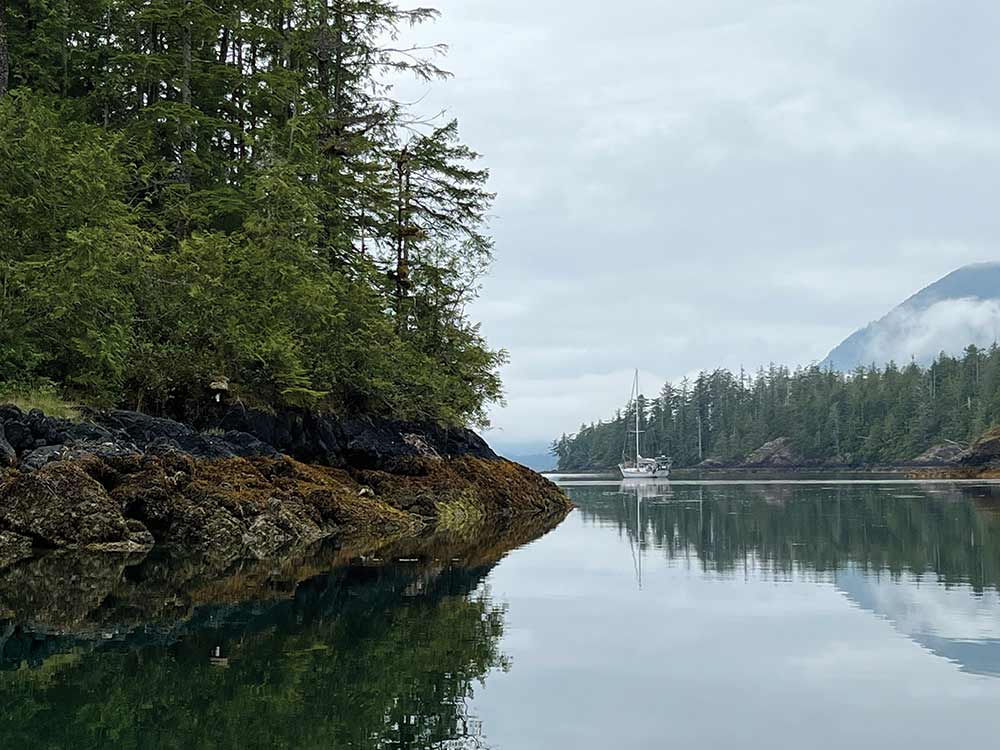
Truth be told, I was feeling pretty anxious about “the big three” as we motored toward Bull Harbour that afternoon. I get this way anytime we push the boat or ourselves outside of the normal comfort zones and especially when we are in new, unfamiliar waters. I had spent many hours planning the passage, understanding the options and studying the weather forecasts. This was a big deal for us, and we had plan A, B, C, and D in mind. But I also knew that any one of those plans might not work if the stuff really hit the fan.
And that’s when I spied the first of the Dall’s porpoises. Within a few minutes, three of them were playing in our bow wave, having a grand time as each took a turn surfing across it. We watched — delighted, as the dolphins seemed to be — and decided this had to be a good omen.
We were still a few hours from Bull Harbour, and Deborah headed down for an afternoon nap. Rather than getting thicker, the fog in Goletas Channel lifted to reveal a sky that was starting to clear. The current was in our favor, speeding us along.
Bull Harbour was soon drawing near — and so was the bar. We’d planned to spend the night there and get up early to catch the early morning slack at the bar.
As the boat hummed along over flat water and no wind, I started going over the preplanned options in my head. I took another close look at the weather forecasting models. And then remembered that the moon would be full that night.
A new and unconsidered option dawned on me. What if we just kept going?
At the rate we were going, we would hit the bar about two hours before slack. That’s far from ideal. But the current would both be in our favor — and weakening so we could turn around and head for Bull Harbour if the conditions turned out to be too rough. The swells were forecast to be less than 1 meter. And the wind was supposed to stay light and favorable for us until at least the next day. After that, though, a low-pressure system was heading our way and we were looking at a few days of contrary and perhaps gale-force winds.
If we did keep going across the bar, we would hit Cape Scott around sunset. From there, another 90 minutes would see us to Sea Otter Cove. I quickly rejected that idea, because I didn’t want to navigate our boat into the cove at night. Winter Harbour seemed like the next logical stop. We could get down there by around 2:30 a.m. and drop the hook.
But if the conditions were as good as forecast, we could just keep going farther still. After all, one of our goals for the cruise was to do our first offshore overnight passage together. We just didn’t know when the conditions would be right for that. As it turned out, that night would be just about ideal.
The Nahwitti Bar, Cape Scott, and the Brooks Peninsula all in one overnight passage? Why, that would be the boating version of a hat trick!
I was getting close to the bar — and decision time. Deborah was still down below napping, which was great, because it meant she would be well rested for the first night watch from 10 p.m. to 2 a.m. Although we normally discuss big changes in plans, I felt confident that Deborah would agree with this one.
The bar appeared relatively flat from about a half-mile out as I scanned that area carefully with my binoculars. All systems go. But I soon discovered that looks can be deceiving.
The seas were a bit bigger than I thought. We took a few hits of green water over the bow as we plunged ahead. Nothing our boat couldn’t handle and, frankly, we’ve been through worse on the Strait of Juan de Fuca.
But the boat’s slamming motion and noise down below woke Deborah up and both she, and our cat, expressed a bit of surprise and annoyance that their restful slumber had been so rudely disturbed. Around 20 minutes later, we were through the worst of it and on our way to Cape Scott.
We enjoyed a light, late dinner as we approached Cape Scott and the sun began to touch the horizon over the Pacific, a sight we Salish Sea cruisers rarely get to enjoy. Deborah read aloud a chapter from the Northwest boating classic The Curve of Time, which had been our literary companion during this cruise. The swell of the ocean gently lifted and lowered us. Only the sound of the engine intruded on this idyllic time, since the wind remained too light to sail.
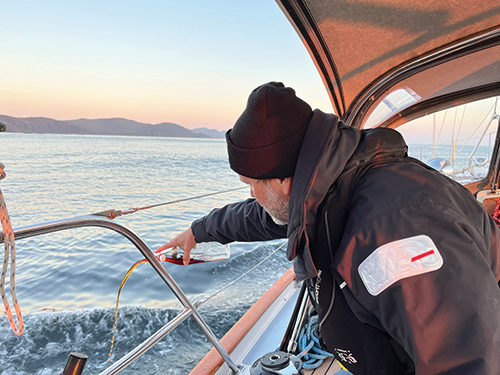
As we rounded Cape Scott just past sunset, a big, bright orange moon rose over Vancouver Island. We poured a shot of rum into the water and gave thanks to all the proper deities for allowing us to reach this cruising milestone.
Then we settled into a long and uneventful night, passing Winter Harbour and later, the Brooks Peninsula, just as the gray light of nautical dawn heralded the start of the new day.
We dropped anchor in Scow Bay, a lovely nook in the Bunsby Islands, later that morning.
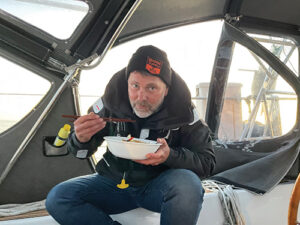
We were tired from our interrupted sleep but exhilarated by a passage through three of the most challenging obstacles of our cruise. We had lots of options as we set out from Port Hardy, but the best option, it turned out, was to keep our options open.
And those three playful porpoises, which seemed to be nudging us along, gave us just the encouragement we needed.
Marty McOmber is a Pacific Northwest sailor, writer, and strategic communications professional. He is currently working on refitting and improving his 1984 Passport 40, Rounder, for continued cruising adventures near and far.






